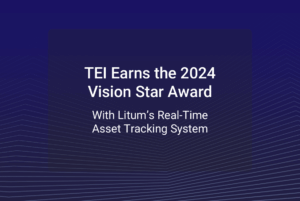- Litum not only has expertise in RTLS technology in industrial settings but in healthcare, serving both verticals with a single platform.
- The company’s 6.1 release comes with about 20 new features such as lower power consumption, security and integration of both UWB and BLE.
At first glance, it may seem that warehouse operations and infant safety in hospitals have little in common. Preventing two forklifts from colliding in a warehouse is a very different application than protecting a baby from being removed from a hospital nursery.
However, real-time locating system (RTLS) technology can serve both applications by detecting an action that could take place, using software algorithms to identify what is happening and if necessary, respond with another action to prevent it.
RTLS company Litum commonly serves industrial as well as healthcare applications, in addition to others, and has found that the key features that make the solutions successful extend to a variety of use cases. With that in mind the company recently released a bundled solution platform known as RTLS Version 6.1.
Litum’s New Release
The latest update comes ready to solve common challenges in both logistics and healthcare, as well as other verticals, and can be customized from there, to enable a faster, effective and low cost deployment. 6.1 offers a variety of new features, including lower power consumption, hybrid functionality to manage data from ultra-wideband (UWB) and Bluetooth Low Energy (BLE) transmissions, and seamless operation both indoors and outdoors, said Ken Rawlings, Litum’s technology product executive.
“For us, 6.1 was the culmination of our technologies that have spanned different verticals and use cases,” said Rawlings.
Version 6.1 incorporates both healthcare and industrial features that have been customer validated, the company said, within a single RTLS platform that Litum can then adjust to the more nuanced demands of these sectors.
Commonalities Across Business Verticals
In fact, said Rawlings “we’ve spent a lot of time over the last four-or five years developing solutions in healthcare and in industrial sectors.”
Litums’ RTLS solution for industrial use cases, traditionally provided with UWB functionality, includes Enhanced Forklift Collision Warning. The system tracks the location of lift-trucks, other vehicles, and people; can sound or display alerts if a forklift is detected to be approaching another vehicle or pedestrian; and it can be tailored to automatically slow down vehicles as well.
Hospitals are using those same algorithms to protect infants or patients at risk of wandering. If the patients are wearing an RTLS badge or band, the system can identify where that individual is and when they approach a restricted area (such as an elevator or exit door). The system can then alert hospital staff or lock a door to ensure an at-risk patient doesn’t leave a safe area.
Integrating BLE with UWB
The new platform comes with about 20 other features that improve on the company’s existing offerings, according to Rawlings.
One new feature with 6.1 is the integration of both UWB and BLE. While Litum has specialized in UWB, “over the past several years we saw more and more customers looking to do high precision asset or employee tracking and then also looking to incorporate in lower value assets,” said Rawlings.
While those lower value assets have often been tracked with passive RFID, the use of BLE enables RTLS data built into the same platform that captures the UWB data.
Tailoring Usage
In some cases, companies benefit from deploying UWB for assets or applications that require highly granular location data. They may, however, prefer BLE beacons in cases in which a zone level accuracy provides enough data, which saves cost.
“The integration of these technologies provides a hybrid RTLS foundation that can be used for a wide variety of location-based applications that provide up to room level location accuracy, or even sub-meter accuracy with UWB,” said Rawlings.
Currently Litum’s platform supports third party BLE tags but its next generation sensor devices will incorporate dual chips enabled with BLE and UWB, the company reported.
Reduced Power, On-premise or Cloud Software
By making software improvements on power requirements, Litum tags using 6.1 will operate 50 percent longer than predecessor systems, reducing the need for frequent charging. This translates into reduced maintenance costs and enhanced operational reliability, ensuring that critical tracking functions are always active, Rawlings said.
Part of these energy-efficiency changes involve enabling the pinging rate of devices to be reduced. Users could construct a sleep mode in their device to configure a patient band to transmit less often if the patient is not moving (for when they are sleeping).
One key feature of 6.1 is the ability for the solution’s software platform to be deployed on premise or in the cloud, hosted by Litum. Many of the company’s customers, such as healthcare companies, prefer to manage all data locally for the security of their patient data.
Improved Security and Mobile App in Unified System
Another 6.1 features is called High Availability and Enhanced Security, for both on-premise and cloud platform deployments to ensure continuous operation. Rawlings said this is crucial for real-time decision-making and maintaining mission-critical environments
Additionally, the company reports that it can offer redundant server deployment options—with the ability to manage highly encrypted data transfers that allows the flow from the devices vis the server into the cloud to be encrypted with transport layer security (TLS).
The 6.1 platform comes with a new mobile app for tag assignment as well. This is an expandable app for streamlining device management with a user-friendly interface. It comes with QR scanning ability for rapid tag assignment and is compatible with Android and iOS platforms. Company officials said the goal is to simplify setup procedures and enhance user interaction.
Ease of Deployment in Any Sector
Because Litum has experience in multiple verticals, the new solution can be more easily deployed across a variety of applications, relying on the company’s RTLS background, said Rawlings.
“When we’ve talked to our system integrators and implementation partners, we hear that a lot of providers specialize on different aspects of the technology [and business sectors]—they might just be a BLE provider for healthcare or they may focus on UWB for asset tracking,” said Rawlings. “I think what we’re showing here is a flexible platform multiple use cases.”
Rawlings added that while some companies’ solutions can provide location positioning, “they can’t apply the complex business rules and alarming logic,” that Litum has developed.
Additionally, the system can incorporate in GPS data into the 6.1 solution to enable outdoor and indoor positioning for systems that need to expand into a yard, campus or parking area.




